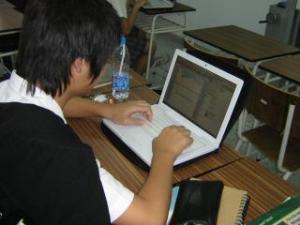 At our rather large high school in Thailand, we have a 1 to 1 laptop program. Every student in the high school has a laptop, which they are supposed to bring to class. After a year and half working with these laptops, I discovered the joys and pitfalls of such a system.
At our rather large high school in Thailand, we have a 1 to 1 laptop program. Every student in the high school has a laptop, which they are supposed to bring to class. After a year and half working with these laptops, I discovered the joys and pitfalls of such a system.
The really nice thing about the laptops is that you can plan activities that require a computer much more easily than schools where you have to book time in a computer lab. Having done both, the laptops are just plain easier to work with.
Another advantage of the laptop program is that a greater percentage of the students you work with have an intermediate level understanding of how their computers work. They can manage their documents in a relatively organized fashion, install software, navigate the web, and use a search engine, all with relative ease. It has been very rare when I have not been able to explain to one of my students how to accomplish a task. I find myself being able give instructions to the students using higher level skills and more complicated phrases than my previous school.
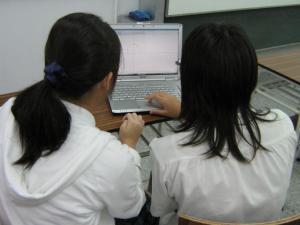 For example, I can tell the kids to ‘copy and paste’ and to ‘create a screen-shot’ and most of the kids know how to do this stuff. I can also give instructions like ‘copy the URL for the image and paste it into the textfield on the image uploader’ and they can do it.
For example, I can tell the kids to ‘copy and paste’ and to ‘create a screen-shot’ and most of the kids know how to do this stuff. I can also give instructions like ‘copy the URL for the image and paste it into the textfield on the image uploader’ and they can do it.
Another nice feature of the 1 to 1 laptop program is that it allows me to include a little bit of tech training in my lessons. Since it is likely that the students will be using a computer pretty regularly for the rest of their lives, it seems to me that the use of a computer is one of the most important skills I can pass along to my students.
Since the students have access to a computer at any time, you can use a number of online tools quite effectively. I have mentioned in a previous article about using Google Docs for collaboration online, and with my classes I have also successfully used blogs, wikis and other resources I have found online with my students.
There are a number of problems with the use of the laptops however which need to be pointed out.
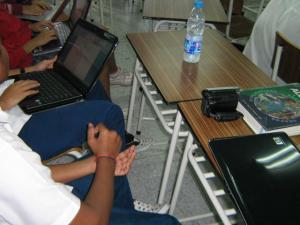 The first problem is that if you plan a lesson that involves everyone needing a laptop and one or more students does not have their laptop, you can find yourself going to your backup pretty quickly. Students have difficulty keeping their laptops virus clear because of all of the file sharing they do. They also sometimes just forget their laptops at <insert the location here>.
The first problem is that if you plan a lesson that involves everyone needing a laptop and one or more students does not have their laptop, you can find yourself going to your backup pretty quickly. Students have difficulty keeping their laptops virus clear because of all of the file sharing they do. They also sometimes just forget their laptops at <insert the location here>.
Another problem, at least at our school, is that there seem to be some limits as to how many students can access a wireless acccess point at the same time. So once the first 15 or so students in your class get started, the next 5 or 10 students are locked out. This can be pretty frustrating pretty quickly.
Students will also tend to use their laptops for inappropriate things during your lessons. The student in the back that you think is diligently using their laptops for taking notes is probably text chatting with their friend in Physics or Biology. Students who are supposed to be carefully working from a PDF version of their textbook are actually surfing blogging sites looking for next year’s fashion. This can be real problem, and as usual you need to rely on your own classroom management skills to try and curb this kind of behaviour. Some schools install special software on the network server to limit students access to the internet, but the kids in your class will probably just turn to computer games instead.
When all is said and done, I have enjoyed the access to a 1 to 1 laptop program I have had at my current school. There have been some problems, but they have not been insurmountable. It is likely that more and more schools will be looking to initiate similar programs, so we as educators must prepare for the future.
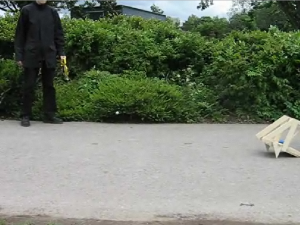 A project I have done with my 9th grade students now for 4 years in a row, is to have them do some quadratic modelling. When I worked in London, I was really lucky because the students were creating trebuchets and catapults in their Design class. So we had a class where the students took their models they created in Design up to the nearest park, and we took digital footage of the trebuchets in action.
A project I have done with my 9th grade students now for 4 years in a row, is to have them do some quadratic modelling. When I worked in London, I was really lucky because the students were creating trebuchets and catapults in their Design class. So we had a class where the students took their models they created in Design up to the nearest park, and we took digital footage of the trebuchets in action.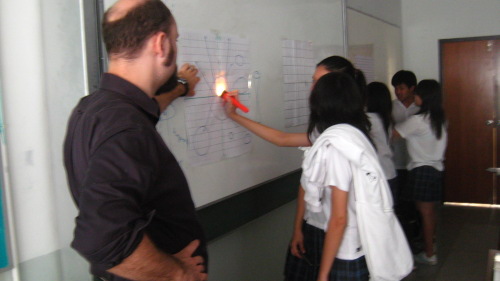 Update: It’s amazing how much my thinking has changed since I wrote this post. I literally cringed as I read the part about homework & test scores.
Update: It’s amazing how much my thinking has changed since I wrote this post. I literally cringed as I read the part about homework & test scores.